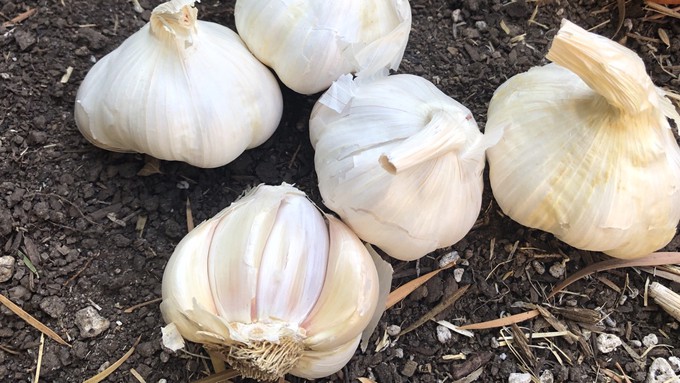
Keeping pests away, the stinky plant makes a great companion to other vegetables

Garlic is a natural pest deterrent as well as a culinary delight. Kathy Morrison
Get a head start on a more flavorful 2023 – and protection for your vegetable garden from pesky pests. Plant garlic this fall and enjoy its many (fragrant) benefits.
Garlic is now available from such mail-order seed companies as Peaceful Valley Farm and Garden Supply in Grass Valley as well as local nurseries. It can be planted from October through December for harvest next summer, though earlier is better.
Garlic ranks as the most popular vegetable to plant among American gardeners, according to recent surveys. Why? We eat a lot of it, on average 2.5 pounds per person each year.
California, which produces most of the nation’s garlic supply, has an ideal climate for this onion cousin. According to UC Davis research, the best varieties to grow in the Sacramento area are “softneck” or silver skin garlics. They put all their energy into producing fat bulbs underground and rarely bolt. The most popular softneck varieties for our climate: California Early and California Late.
“Hardneck” varieties, also called “top-setting garlic,” also grow well in our area. Hardnecks produce a strong stem or scape, which is a spring vegetable all its own. These varieties often have purple or red skins and evocative names such as Purple Italian, Russian Red and Spanish Roja.
In addition to its culinary assets, garlic is a natural pest deterrent. Its scent keeps a wide range of pests away from neighboring plants including codling moths, spider mites, aphids, ants and snails as well as several species of gnats and flies.
Deer and rabbits don’t like garlic either. Planted along the borders of a garden, garlic can form a scent barrier to hungry critters. Garlic builds up sulfur content in the soil, acting as a natural fungicide. But not all vegetables like this extra dose of sulfur. Avoid planting garlic near peas, beans, asparagus, parsley or sage. (It will actually stunt their growth.)
And even though it's a close cousin to onions, garlic shouldn’t be planted in the same spot where onions have grown in the past two or three years; it can pick up diseases or other issues.
For the best crop, garlic needs full sun and good drainage, but not much room or water.
When planting, break the head apart into separate cloves, each with a little bit of the “foot” attached where they were connected. Plant pointy end up, about 2 inches deep. Garlic can be planted only 3 or 4 inches apart. Water once when freshly planted, then let the cloves rest. After they sprout, they need weekly irrigation if there’s no rain.
Baby garlic plants don’t like competition; remove any weeds that try to crowd them out.
For more tips on growing garlic: https://vric.ucdavis.edu/veg_info_crop/garlic.htm
Comments
0 comments have been posted.Sacramento Digs Gardening to your inbox.
Sites We Like
Garden Checklist for week of July 21
Your garden needs you!
* Keep your vegetable garden watered, mulched and weeded. Water before 8 a.m. to reduce the chance of fungal infection and to conserve moisture.
* Feed vegetable plants bone meal, rock phosphate or other fertilizers high in phosphate to stimulate more blooms and fruiting. (But wait until daily high temperatures drop out of the 100s.)
* Don’t let tomatoes wilt or dry out completely. Give tomatoes a deep watering two to three times a week.
* Harvest vegetables promptly to encourage plants to produce more. Squash especially tends to grow rapidly in hot weather. Keep an eye on zucchini.
* Pinch back chrysanthemums for bushy plants and more flowers in September.
* Remove spent flowers from roses, daylilies and other bloomers as they finish flowering.
* Pinch off blooms from basil so the plant will grow more leaves.
* Cut back lavender after flowering to promote a second bloom.
* It's not too late to add a splash of color. Plant petunias, snapdragons, zinnias and marigolds.
* From seed, plant corn, pumpkins, radishes, winter squash and sunflowers.